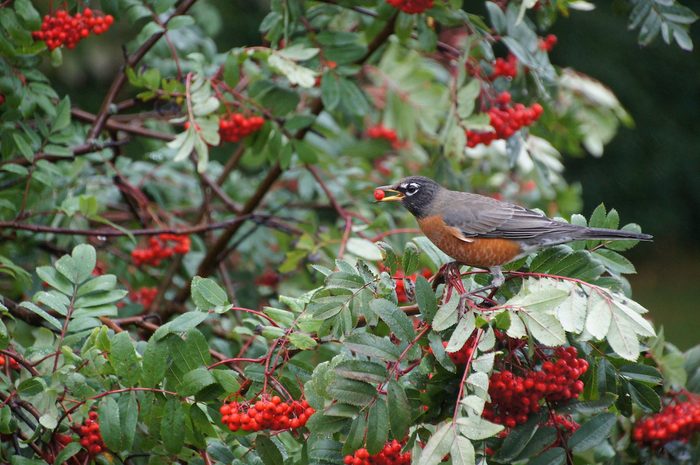Shrubs and plants with red berries add a pop of scarlet-hued color to any garden and provide food for wild birds.

Top 10 Shrubs and Plants With Red Berries


Strawberry Tree
Arbutus unedo, Zones 7 to 10
This slow-growing evergreen shrub or small tree is native to western Europe and thrives in warmer climates. The glossy leaves, white flowers, and red berries or drupes provide interest in every season. Harvest the fruit in autumn and use it in jams and jellies. Be careful: It bruises easily.
Why we love it: Pollinators enjoy the nectar, and small mammals and birds are attracted to the high sugar content in the fruit.

Bunchberry
Cornus canadensis, Zones 2 to 6
Common in forests throughout Canada and the northern United States, this spreading ground cover is a great choice for gardens in cool climates. Features include glossy green leaves that transition to red and purple in the fall and small white flowers that give way to clusters of berrylike drupes that ripen in August and last until fall.
Why we love it: Rabbits and deer steer clear of this plant.

Lingonberry
Vaccinium vitis-idaea, Zones 2 to 7
This creeping evergreen shrub forms dense mats, but it’s not the leatherlike oval leaves that make it popular; it’s the plant’s red edible berries that appear twice a year. Eaten raw, the fruits have a bitter taste, but they make an ideal replacement for cranberries when cooked (hence the alternate moniker, northern mountain cranberries).
Why we love it: Lingonberries are superfruits and have the highest antioxidant content of all berries.

Common Winterberry
Ilex verticillata, Zones 3 to 9
This low-maintenance member of the holly family is a deciduous shrub that grows well in moist, acidic soil. When cross-pollinated, winterberry plants produce red berries that emerge in August and last through winter, giving strong interest after the leaves fall off.
Why we love it: It’s a host plant for pollinators, and it attracts more than 40 species of birds. The most common berry eaters are cedar waxwings, thrushes, bluebirds, yellowrumped warblers, woodpeckers, northern mockingbirds and American robins.

Red Chokeberry
Aronia arbutifolia, Zones 3 to 9
Native to the eastern U.S., this deciduous shrub has green leaves that transition to orange-red or purple in fall, and it produces clusters of white to light pink flowers in the spring. The bright red, pear-shaped berries that appear in fall make the shrub popular for four-season interest.
Why we love it: The plants produce pectin-rich red berries that make thick, sweet jams and jellies.
Psst—also try growing black chokeberry shrubs for berry-loving birds.

Chinese Evergreen Dogwood
Cornus capitata subsp. angustata, Zones 6 to 9
This evergreen reaches 12 to 20 feet and produces profuse, long-lasting white blooms in spring. Oblong green leaves turn shades of purple in fall, and green fruits ripen to a rich red. Although the fruits are edible, their flavor is unappealing.
Why we love it: It blooms later than native dogwoods, which extends the seasonal interest.

American Holly
Ilex opaca, Zones 5 to 9
The iconic red berries appear from September to December and complement the glossy, spine-tipped green leaves. This evergreen is so popular as a holiday decoration that it’s often called Christmas holly. Both male and female plants are required to produce the hallmark berries.
Why we love it: The trees can reach up to 60 feet tall, making holly bushes ideal privacy screens or hedges.

Silver Buffaloberry
Shepherdia argentea, Zones 3 to 9
The silver-scaled leaves drop in fall, revealing silver-toned branches. Female plants produce sour, pea-sized red fruits. The plant reaches a mature height of 12 feet, has a tendency to form thickets, and tolerates both drought and moist soils.
Why we love it: The fruits are actually stone fruits that can be eaten fresh or used in baked goods.

Bearberry Cotoneaster
Cotoneaster dammeri, Zones 5 to 8
These plants grow just 1 foot tall but spread up to 6 feet wide, forming thickets. Green leaves transition to shades of reddish bronze or purple in fall. The bearberries, a food source for birds and bears, last from summer through winter.
Why we love it: It can be grown in containers, making it an ideal patio plant.

Red Lake Currant
Ribes rubrum, Zones 3 to 7
The leaves are aromatic when crushed, and the abundant clusters of red berries have a tart flavor, making them popular for a range of culinary uses including preserves and pies. It can take up to five years for these deciduous shrubs to reach their full fruit-bearing potential.
Why we love it: These plants with red berries are attractive to birds but rabbit resistant.

Bonus Berry Plant Picks
Even more berry-producing shrubs to grow
- American mountain ash (Sorbus americana)
- Butcher’s broom (Ruscus aculeatus)
- Serviceberry (Amelanchier)
- Spotted laurel (Aucuba japonica)
- Wild coffee plant (Psychotria nervosa)
Sources
- North Carolina Cooperative Extension – Arbutus unedo
- Missouri Botanical Garden – Cornus canadensis
- National Library of Medicine – Lingonberry
- Missouri Botanical Garden – Vaccinium vitis-idaea
- Lady Bird Johnson Wildflower Center – Vaccinium vitis-idaea
- North Carolina Cooperative Extension – Ilex verticillata
- North Carolina Cooperative Extension – Ilex opaca
- U.S. Forest Service – American holly
- Missouri Botanical Garden – Shepherdia argentea
- McKay Nursery – Red Lake Currant
- Missouri Botanical Garden – Ribes rubrum ‘Red Lake’
- North Carolina Cooperative Extension – Cotoneaster dammeri
- North Carolina Cooperative Extension- Cornus capitata subsp. angustata
- North Carolina Cooperative Extension – Aronia arbutifolia


